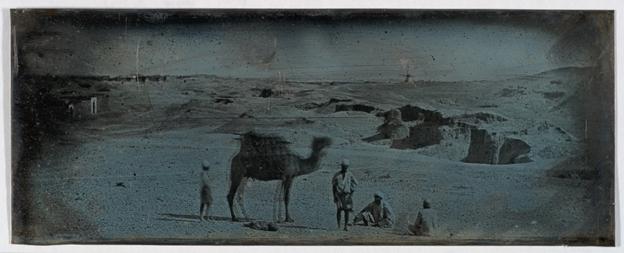
Credit: The Metropolitan Museum of Art
The Metropolitan Museum of Art (The Met) and The University of New Mexico (UNM) today announced the groundbreaking findings of a two-year study of the plasmonic properties of daguerreotypes.
Using atomic force microscopy and scanning electron microscopy, together with numerical calculations, the team of scientists from The Met and UNM, in collaboration with Century Darkroom, Toronto was able to determine how the light scattered by the metallic nanoparticles on the surface of a daguerreotype determines the characteristics of its image, such as shade and color.
The pioneering research– recently published in the journal PNAS–not only provides an in-depth understanding of these 19th century photographs that are crucial for their preservation, but also introduces new possible approaches for color printing where nanostructures are directly manufactured by light.
“We are thrilled by these findings that help us better understand the fascinating properties of daguerreotypes and shed light on how to continue to advance the preservation of these incredible works of art,” said Silvia A. Centeno, Research Scientist in the Department of Scientific Research at The Metropolitan Museum of Art.
“The team at the University of New Mexico embarked on this study to achieve a better understanding of the mechanisms that give rise to the optical response of daguerreotypes and to contribute to the development of protocols for preserving these fragile artifacts,” said Alejandro Manjavacas from the Department of Physics and Astronomy at The University of New Mexico. “Thanks to the fantastic teamwork between scientists from both the cultural and scientific communities we were able to accomplish what we set out to do.”
Unlike other types of photographs, daguerreotypes rely on light scattering by metallic nanoparticles to create images that project off a reflective silver substrate. These early photographs can be recognized as the first examples of plasmonic color printing, an emerging research field that exploits the interactions between light and metallic nanostructures to produce vivid colors.
The image tones of a daguerreotype are dynamic and unique in that they can change with the viewing angle and, for the first time, this effect is explained by the authors, who found that the morphology and size of nanoparticles determines how these will scatter thus creating the visual outcome of the daguerreotype. Studies of the image properties of daguerreotypes serve to inform the development of preservation protocols, as well as novel approaches to future color printing technologies inspired by past ones.
###
The team of scientists consisting of Andrea Schlather and Silvia A. Centeno from the Department of Scientific Research at The Metropolitan Museum of Art, Paul Gieri and Alejandro Manjavacas from the Department of Physics and Astronomy at The University of New Mexico, and Mike Robinson from Century Darkroom, Toronto collaborated on this study. The research was sponsored in part by The National Science Foundation and by the Annette de la Renta Foundation, and made use of the computational facilities provided by the UNM Center for Advanced Research Computing.
About The Metropolitan Museum of Art
The Met presents over 5,000 years of art from around the world for everyone to experience and enjoy. The Museum lives in three iconic sites in New York City–The Met Fifth Avenue, The Met Breuer, and The Met Cloisters. Millions of people also take part in The Met experience online.
Since it was founded in 1870, The Met has always aspired to be more than a treasury of rare and beautiful objects. Every day, art comes alive in the Museum’s galleries and through its exhibitions and events, revealing both new ideas and unexpected connections across time and across cultures.
The Department of Scientific Research at The Met is responsible for investigating the material aspects of works of art in the collection. Scientists in the department collaborate with conservators and curators in studying, preserving, and conserving the works, and also pursue innovative research in analytical techniques, preventive conservation, and treatment.
The University of New Mexico
Founded in 1889 as New Mexico’s flagship institution, The University of New Mexico now occupies nearly 800 acres near old Route 66 in the heart of Albuquerque, a metropolitan area of more than 500,000 people. From the magnificent mesas to the west, past the banks of the historic Rio Grande to the Sandia Mountains to the east, Albuquerque is a blend of culture and cuisine, styles and stories, people, pursuits and panoramas.
UNM is a place where cutting-edge research and creative endeavors flourish injecting millions of dollars into New Mexico’s economy, funds new advancements in healthcare, and augments teaching – giving students valuable hands-on training in state-of-the art laboratories.
UNM is one of only a dozen Hispanic-Serving Institution in the U.S. that are also classified by the Carnegie Commission on Higher Education as a R1: Doctoral Universities with very high research activity.
Media Contact
Alejandro Manjavacas
[email protected]




